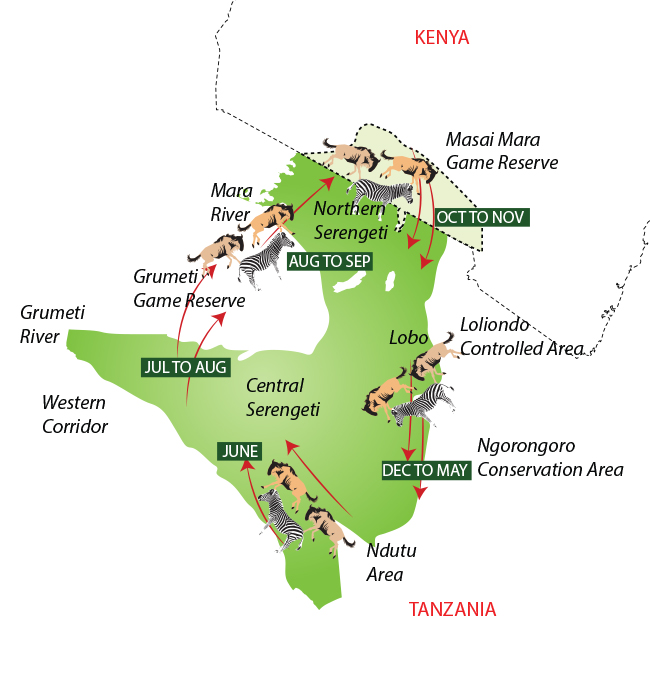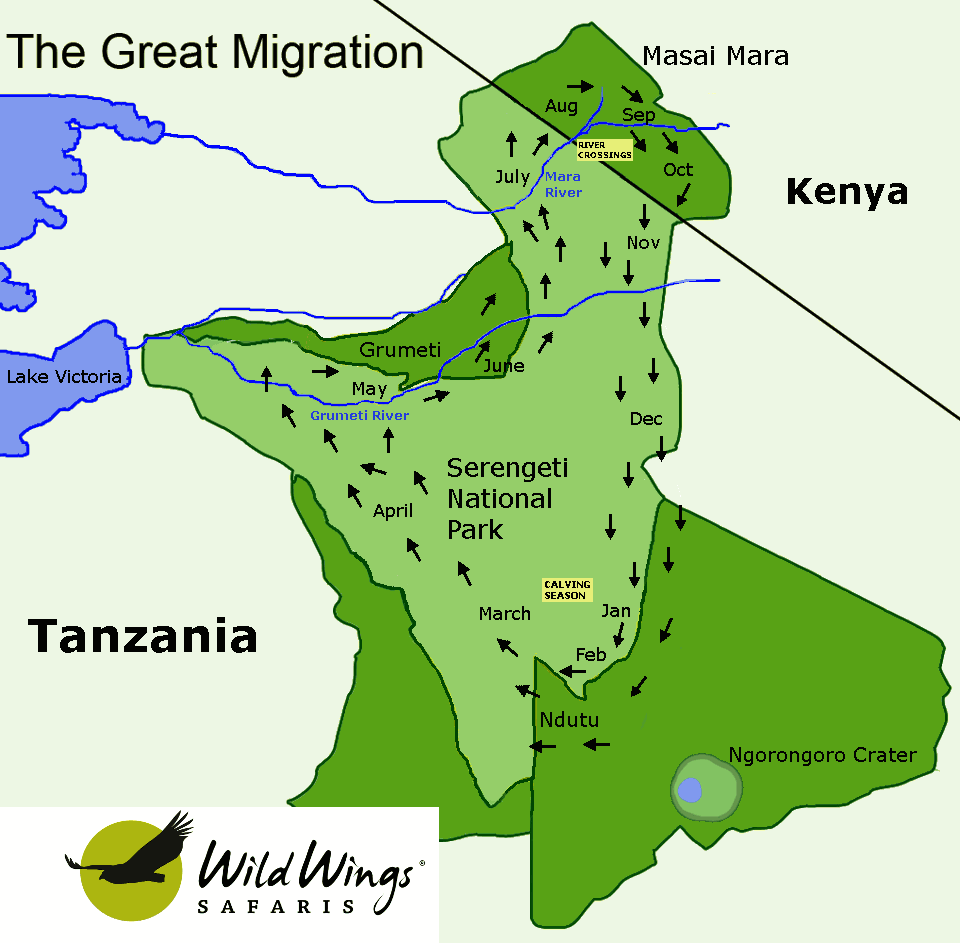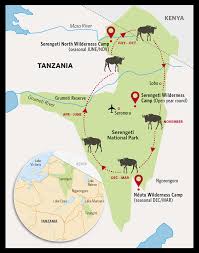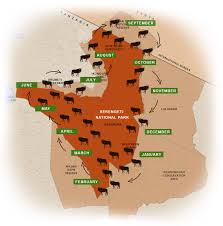1. Introduction
The Great Migration is often described as one of the most awe-inspiring natural phenomena in the world. Each year, over 1.5 million wildebeest, accompanied by hundreds of thousands of zebras and gazelles, traverse the vast plains of the Serengeti in search of fresh grazing lands and water. This annual migration, covering over 800 Kilometers, represents the heartbeat of the Serengeti ecosystem. As a conservationist, understanding the ecological significance of this event is essential, as it underscores the interconnectedness of species, land, and climate.
The migration is not just about vast herds of animals; it is a complex dance of life and death, survival and reproduction, all intricately tied to the rhythms of nature. The health of the Serengeti ecosystem is intimately linked with this migration, and any disruption—whether from climate change, human activity, or habitat loss—could have devastating effects. This guide provides a deep dive into the mechanics of the Great Migration, the wildlife involved, the challenges faced, and conservation efforts aimed at preserving this world wonder.
2. The Great Migration: An Overview
What is the Great Migration?
The Great Migration is a circular journey that spans across Tanzania’s Serengeti National Park and Kenya’s Maasai Mara Reserve. The primary driver of this movement is the search for food and water, as wildebeest and other herbivores follow the rains across the region. The migration is an essential part of the Serengeti ecosystem, allowing the grasslands to regenerate, enriching the soil with nutrients from dung, and maintaining a balance between predators and prey.
During the migration, wildebeest give birth to roughly 500,000 calves, all born within a two- to three-week window. This synchronized birthing ensures that enough young survive the onslaught of predators, especially lions, cheetahs, hyenas, and crocodiles, which follow the migration closely. The wildebeest are the primary players, but they are accompanied by around 250,000 zebras and 300,000 Thomson’s gazelles, making it a vast, dynamic event that impacts every facet of life in the Serengeti.
Key Statistics of the Migration
- Number of Wildebeest: Over 1.5 million.
- Other Species: 250,000 zebras, 300,000 gazelles.
- Distance Covered: 800 Kilometers annually.
- Time Frame: Year-round, although the movement varies depending on seasonal rains.
Seasonality of the Migration
The migration follows a seasonal pattern that is dictated by the availability of fresh grass and water. It starts in the southern Serengeti plains in Tanzania, where the wildebeest give birth, and then moves northward towards the Maasai Mara in Kenya before looping back again. The migration is cyclical and driven by the region’s two main rainy seasons, the long rains from March to May and the short rains in November.
Why Do They Migrate?
Key Reasons Wildebeest Migrate: Updated Insights
- Chasing Grass and Water The primary reason for wildebeest migration is to follow seasonal rains, which trigger the growth of fresh, nutrient-rich grass. As the Serengeti dries up, the herds are drawn northward into the Masai Mara, where conditions are more favorable. This migration is a matter of survival, as wildebeest, zebras, and gazelles move in sync with the rain, ensuring they always have access to food and water.
- Competition for Grazing While earlier studies suggested that wildebeest, zebras, and gazelles followed a cooperative grazing relay—zebras eating tall grass first, followed by wildebeest and then gazelles—recent research by Anderson (2024) complicates this picture. The “push-pull” hypothesis suggests that instead of cooperation, there’s intense competition between these species for the most nutrient-rich grass. Zebras, as bulk feeders, must stay ahead of the wildebeest to access the best forage, driving much of their movement.
- Safety in Numbers Another driving force behind the migration is protection from predators. By traveling in massive herds, wildebeest reduce the likelihood of individual animals being targeted by predators like lions, hyenas, and cheetahs. This “safety in numbers” concept, as noted in Schaller’s studies (1972), makes migration a key survival strategy. The sheer size of the herds overwhelms predators, making it difficult for them to single out and capture prey.
These key factors—food availability, competition, and predator avoidance—combine to drive the annual Great Migration, a complex and essential survival mechanism for the Serengeti’s wildlife.
4. The Migration Route and Map
Understanding the Route
The migration moves in a clockwise direction across the Serengeti and Maasai Mara. Starting in the southern Serengeti, the herds head northwest toward the Grumeti River before crossing into the Maasai Mara and eventually returning south.
Important Stops Along the Way
- Serengeti Plains: Starting point for calving.
- Grumeti River: Famous for massive Nile crocodiles awaiting the migrating herds.
- Mara River: The most iconic and treacherous river crossing.
The Role of the Mara River
The Mara River is a lifeline during the migration, but it is also one of the most dangerous obstacles. Wildebeest and zebras face not only the strong currents but also lurking crocodiles, making this one of the most dramatic scenes in nature.
Migration Schedule and Route
December – April: Calving Season in Ndutu and Southern Serengeti Plains
During the months from December to April, the Serengeti comes alive in the southeast near the Ndutu area and the surrounding plains that stretch towards Ngorongoro Conservation Area. These open, nutrient-rich grasslands are ideal for calving. Hundreds of thousands of wildebeest, zebras, and gazelles gather here, as the rains bring fresh grasses to nourish the herds. This period is crucial as it is the calving season, where up to 500,000 wildebeest calves are born, providing a feast for predators like lions, cheetahs, and hyenas. The southeastern plains around Ndutu, Lake Masek, and Lake Ndutu become hotspots for predator-prey interactions, as large carnivores follow the herds closely.
May – June: Movement Towards the Western Corridor
As the rainy season begins to end in May, the herds start moving northwest towards the Grumeti River in the Serengeti’s Western Corridor. The once lush plains begin to dry out, pushing the animals to seek more reliable water sources. By June, vast columns of wildebeest and zebras can be seen making their way towards the Grumeti, where they will face one of their most perilous challenges—crossing the crocodile-infested river. During this time, the woodlands and savanna of the Western Corridor come alive with the sights and sounds of migration, as the herds stretch for miles in long, unbroken lines.
July – August: Crossing the Grumeti and Mara Rivers
By July, the migration is in full swing as the herds cross into the Northern Serengeti and towards the Maasai Mara in Kenya. The Mara River, with its treacherous crossings, becomes the focal point. Thousands of wildebeest risk their lives as they plunge into the river, facing strong currents and waiting crocodiles. The crossing is not only a spectacle but a crucial passage for the herds to access the greener pastures of the Maasai Mara. From July to August, this region becomes a vital feeding ground for the animals, and the Mara’s rolling hills and acacia woodlands provide temporary respite before the long journey back south.
September – October: Grazing in the Maasai Mara
As the dry season intensifies, the herds remain in the Maasai Mara, feeding on the rich grasses of Kenya’s reserve. September and October are typically marked by the last of the major crossings, with stragglers still making their way north or already turning southward as the grasses start to dwindle. The Maasai Mara, with its rolling hills and vast open spaces, becomes home to the wildebeest for a few more months as they graze and build strength for the return journey. Predators, particularly the large lion prides of the Mara, continue to hunt the herds during this time, keeping the natural cycle in motion.
November: Return to the Serengeti Plains
By November, the first rains begin to fall in the southern Serengeti, signaling the herds to start their journey back to the plains. Slowly, they leave the Maasai Mara and retrace their route southward, moving through the Northern Serengeti and back to the eastern and southern plains. The herds return to the Ndutu area and other regions of the southern Serengeti just in time for the next calving season. This period marks the completion of a full migration cycle, as the wildebeest prepare to birth the next generation and begin the journey all over again.
Great Migration Maps
5. Wildlife of the Serengeti Great Migration
Wildebeest: The Main Actors
Wildebeest, often referred to as the “clowns of the savannah” due to their quirky and awkward appearance, are the driving force behind the Great Migration. Their mass movement is essential for the Serengeti ecosystem, preventing overgrazing and promoting the cycling of nutrients back into the soil. As they move, they shape the landscape and create opportunities for other species to thrive, making them the central figures in this monumental journey.
Other Migrating Species
Zebras: Unlike the wildebeest, zebras migrate alongside them but play a different role in the ecosystem. Zebras graze on the tougher grasses, clearing the way for the wildebeest to feed on the more tender shoots. Their close-knit migration with the wildebeest creates a harmonious balance that sustains the Serengeti’s grasslands.
Gazelles: The smaller but agile gazelles follow the migration route, avoiding larger predators by using their speed. Though less visible compared to the wildebeest and zebras, gazelles are a crucial part of the migration, contributing to the overall biodiversity of the ecosystem.
Predators and the Migration
Lions: Often referred to as the kings of the Serengeti, lions closely follow the migration, taking advantage of the weak and vulnerable individuals within the herds. The abundance of prey during the migration fuels the health and growth of lion prides.
Cheetahs: Unlike lions, cheetahs prefer the open plains, where they use their speed to hunt down fast-moving prey like gazelles. The migration season offers cheetahs ample hunting opportunities.
Hyenas: Opportunistic and intelligent, hyenas are particularly active during the calving season. They are both predators and scavengers, feeding on wildebeest calves and any carcasses left behind by larger predators.
Crocodiles in the Mara and Grumeti Rivers
The Mara and Grumeti rivers are infamous for their large populations of Nile crocodiles, which lay in wait as the migrating herds cross. These river crossings are some of the most perilous moments for the wildebeest and zebras, with many falling prey to the crocodiles’ powerful jaws. These crossings offer dramatic scenes of life and death, highlighting the harsh realities of the Great Migration.
6. Migration Safari Options
Safari Packages and Tours
Many safari operators offer migration-specific tours, allowing visitors to witness iconic moments like river crossings or the calving season. These tours range from luxury to budget, with expert guides who have deep knowledge of migration patterns, ensuring visitors have the best chances of catching the action.
Private vs. Group Safaris
Private Safaris: A private safari offers a more personalized and intimate experience, often tailored to the preferences of the visitors. However, this option comes with a higher price tag.
Group Safaris: More affordable than private safaris, group safaris provide a social and communal experience. They allow travelers to meet fellow adventurers while still offering excellent chances of witnessing the migration.
Budget-Friendly Migration Safaris
For those looking to experience the migration on a budget, there are several options:
- Join Group Tours: Sharing costs with others in a group tour reduces expenses while still providing access to the migration’s hotspots.
- Mobile Camps: These camps move with the herds, offering proximity to the migration at a fraction of the cost of permanent lodges.
- Self-Drive Safaris: For adventurers seeking flexibility, self-driving in the Serengeti offers the chance to follow the migration at your own pace and save on safari packages.
Walking and Hot Air Balloon Safaris
Hot Air Balloon Safaris: For a unique vantage point, hot air balloon safaris provide a bird’s-eye view of the migration. Floating above the Serengeti at sunrise offers breathtaking scenes of the herds moving across the plains.
Walking Safaris: Though less common during the migration, walking safaris offer a more intimate and immersive experience with nature, allowing visitors to observe smaller details of the ecosystem.
7. Accommodation for Migration Viewers
Lodges and Camps Along the Route
Lodges and camps are strategically located along the migration route, ensuring visitors can stay close to the action. From luxury lodges that provide opulent comfort to mobile tented camps that bring you right into the heart of the migration, there is accommodation to suit every preference and budget.
Luxury vs. Budget Accommodation
Luxury Accommodation: Expect all the comforts of home and more, with gourmet meals, spa treatments, and impeccable service. These camps and lodges offer a premium experience, complete with expert guides.
Budget Accommodation: For those on a tighter budget, basic camps offer a more rustic experience but provide a closer connection to the wilderness and a real sense of adventure.
Mobile Camps
Mobile camps move with the herds, ensuring guests are always near the migration. These camps offer an incredible advantage—guests are constantly in proximity to the migration, providing optimal viewing opportunities throughout their stay.
Best Places to Stay to Watch the Serengeti Migration Throughout the Year
| Period | Migration Phase | Key Location | Best Accommodation Options | Features & Highlights |
|---|---|---|---|---|
| December – April: Calving Season | Calving in the Southern Serengeti | Ndutu Plains, Southern Serengeti (near Ngorongoro Conservation Area) | – Ndutu Safari Lodge – Lake Masek Tented Camp – Sanctuary Kichakani Serengeti Camp | – Prime location for viewing wildebeest calving. – Best for predator action (cheetahs, lions). – Flat, open plains for great visibility. |
| May – June: Movement Towards the Western Corridor | Moving through the Central Serengeti | Central Serengeti, Seronera | – Serengeti Serena Safari Lodge – Kubu Kubu Tented Camp – Dunia Camp | – Wildebeest and zebras in transit. – Predator-prey interactions intensify. – Convenient access to Seronera airstrip. |
| July – August: Crossing the Grumeti and Mara Rivers | Grumeti River Crossings (July) and Mara River Crossings (August) | Western Serengeti, Northern Serengeti (Mara River) | – Singita Grumeti Reserves (Western Corridor) – Serengeti Mara Camp (Mara River) – Lamai Serengeti Camp (Northern Serengeti) | – Thrilling river crossings with dramatic crocodile encounters. – Best time for witnessing large herd movements. – Remote, quieter lodges. |
| September – October: Grazing in the Maasai Mara | Grazing in the Maasai Mara after the river crossings | Maasai Mara (Kenya) | – Governor’s Camp – Mara Serena Safari Lodge – Little Governors’ Camp | – Ample grazing and relaxed herds. – Ideal for photography. – Maasai Mara’s most popular months. |
| November: Return to the Serengeti Plains | Return to Southern Serengeti for fresh grazing | Northern & Central Serengeti | – Sayari Camp (Northern Serengeti) – Kati Kati Tented Camp (Central Serengeti) | – Herds move southward back to Ndutu Plains. – Quiet before the next calving season. – Excellent predator action. |
Notable things about Recent Migrations
Here’s a breakdown of some notable moments across these years:
2015
In 2015, the migration’s river crossings in the Mara River were particularly intense due to unusually high water levels, making it one of the deadliest years for the herds. Many wildebeest drowned during the crossings, which led to a large feast for crocodiles, but also caused delays in the progress of the migration as herds hesitated before entering the water.
2016
A late start to the rains in 2016 delayed the migration. The wildebeest herds reached the northern Serengeti later than usual, causing a shorter stay in the Maasai Mara. However, this also led to an extended calving season in the Ndutu region, offering tourists more opportunities to witness new births.
2017
This year was notable for the fast pace at which the herds moved. Due to early rains, the wildebeest crossed the Mara River earlier than expected, resulting in a spectacular sight for early-season visitors. However, fewer crossings were observed later in the year.
2018
2018 was an interesting year with erratic weather patterns. The herds shifted between Tanzania and Kenya more frequently than usual. The Grumeti River crossings were particularly impressive, with large concentrations of wildebeest and zebras navigating through challenging terrains.
2019
2019 witnessed heavy rainfall in the early months, leading to lush pastures across the Serengeti. This created an extended grazing period in central Serengeti, with the herds lingering longer in the region before heading toward the Mara River.
2020
Despite the global pandemic restricting many travelers, the migration continued uninterrupted. Unusually dry conditions in early 2020 resulted in herds lingering in the southern Serengeti for longer than expected. Fewer river crossings were noted due to lower water levels.
2021
After relatively dry conditions in 2020, 2021 saw a rebound with heavy rains. This led to intense river crossings in the Mara and Grumeti Rivers. The Mara Triangle witnessed some of the largest and most dramatic crossings of the past decade, with hundreds of wildebeest making the treacherous journey.
2022
2022 featured heavy rains in the early part of the year, leading to rich vegetation and a healthy calving season. However, flooding in some regions of the Mara delayed crossings, with many wildebeest choosing alternate routes to avoid high water levels.
2023
The 2023 migration saw a perfect balance of rain and dry spells, making for an ideal season for river crossings. The Mara and Grumeti crossings were particularly notable for the large number of predators waiting for the herds. Lions and crocodiles had an abundant feast during this time.
2024
In 2024, early reports have noted the herds moving south faster than anticipated after the river crossings. Large groups have already been spotted moving toward the southern Serengeti by August, suggesting an early return to calving grounds
8. Photography and Videography Tips
Best Spots for Capturing the Migration
Mara River Crossings: If you’re looking to capture dramatic action shots, the Mara River crossings are perfect.
Calving Season: Capture intimate moments of new life in the Serengeti, as wildebeest calves take their first steps and predators loom nearby.
Camera Gear Recommendations
- Zoom Lens: A 100-400mm lens is ideal for capturing wildlife from a distance, ensuring you don’t miss any action while keeping a safe distance.
- Tripod: Stability is key, especially during early mornings or late evenings when light is low.
Timing and Lighting
The best light for photography comes during early mornings and late afternoons. The golden hours create a beautiful, soft glow, perfect for highlighting the herds against the Serengeti backdrop. Midday lighting can be harsh, but it’s ideal for capturing the river crossings.
9. Conservation Challenges and Efforts
Threats to the Serengeti Migration
- Habitat Fragmentation: The spread of settlements, agriculture, and roads threatens the migration routes, reducing the available grazing lands for the animals.
- Climate Change: Altering rainfall patterns could disrupt the migration, as the animals rely on seasonal rains for fresh grazing areas.
- Poaching: Although reduced, poaching remains a significant threat, especially for iconic species like elephants and rhinos that share the Serengeti ecosystem.
Conservation Initiatives
- Anti-Poaching Units: Increased patrols and stricter enforcement of anti-poaching laws have helped reduce illegal hunting.
- Habitat Protection: Conservation efforts are underway to maintain migration corridors and prevent further development in critical areas.
- Community Involvement: Local communities are encouraged to participate in eco-tourism initiatives, offering sustainable income sources while preserving the environment.
How Tourists Can Contribute to Conservation
Tourists play a crucial role in preserving the Serengeti ecosystem. By choosing eco-friendly lodges and camps, supporting conservation organizations, and following responsible tourism practices, they can help safeguard the future of the Great Migration.
10. Conclusion
The Great Migration is more than just an extraordinary wildlife spectacle; it is the lifeblood of the Serengeti ecosystem. For millennia, the migration of millions of animals has shaped the landscape, ensuring the balance between predators and prey. However, the future of this iconic journey depends on our collective conservation efforts. Through responsible tourism, habitat protection, and community involvement, we can ensure that the Serengeti remains a haven for wildlife and a source of wonder for generations to come.
Planning a Great Migration Safari
Here’s how to plan your trip to witness the migration:
- Timing:
- The key to a successful migration safari is timing it right. If you want to see the calving season, visit between January and March in the southern Serengeti. For the famous Mara River crossings, plan your trip for July to October in the northern Serengeti.
- Where to Stay:
- Luxury Lodges: If budget isn’t an issue, staying at luxury lodges like Singita Grumeti or Serengeti Bushtops will put you in the heart of the action with top-notch service and incredible views.
- Mid-Range: Camps like Kubu Kubu Tented Lodge or Lamai Serengeti offer excellent access to the migration without the hefty price tag.
- Mobile Tented Camps: For an immersive experience, mobile camps like Asilia’s Olakira Camp move with the herds, giving you front-row seats to the migration.
- How Long to Stay:
- A typical migration safari lasts around 5-7 days. This gives you enough time to follow the herds and witness key moments like river crossings and predator interactions.
Cost of a Great Migration Safari
The cost of a Great Migration safari varies depending on the time of year, your choice of accommodation, and how you choose to travel (fly-in or drive-in).
- Luxury Safaris: $1,000+ per person per night. These include high-end lodges, private guides, and personalized safaris.
- Mid-Range: $400-$700 per person per night. These safaris offer great value while providing comfortable accommodations and guided game drives.
- Budget Safaris: $150-$300 per person per night. These typically involve camping or staying at basic lodges but still provide access to the migration.
Keep in mind that park fees in the Serengeti are around $70-80 per person per day.
Insider Tips to Maximize Your Migration Safari
- Go mobile: Mobile camps move with the herds, giving you the best chances to see the migration up close. They’re also often more remote, meaning fewer crowds.
- Fly-in safaris: Serengeti is huge, and a fly-in safari can save you hours of driving. This is especially useful if you’re heading to the northern Serengeti for the Mara River crossings.
- Book early: During peak migration times (July-October), lodges fill up fast, so aim to book your safari at least six months in advance.
- Get a good guide: A knowledgeable guide can make all the difference. They’ll know where the herds are and have the skills to get you close to the action without disturbing the animals.
- Be patient: The migration is unpredictable. Sometimes the herds stand on the riverbank for hours before deciding to cross. Bring a good camera, a book, and a sense of adventure.
Key Notable Migration Points
- Ndutu Plains (January-March): The calving season and intense predator action.
- Grumeti River (June): The quieter but thrilling river crossings in the western Serengeti.
- Mara River (July-October): The ultimate migration spectacle. The chaotic river crossings are the highlight of the entire event.
Final Thoughts
Witnessing the Great Migration is a life-changing experience. From the thunderous sound of wildebeest hooves to the heart-pounding moments at river crossings, it’s a spectacle of nature that you’ll never forget. Whether you’re a seasoned safari-goer or this is your first trip to Africa, planning your migration safari carefully will ensure you see this phenomenon at its best.
Pack your sense of adventure, get ready to be amazed, and prepare for the Serengeti to leave a lasting mark on your soul. Safe travels!




